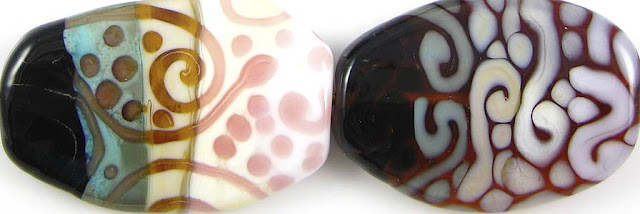1 - Plain, 2 - Plain (reduced), 3 - w/ Silver Leaf, 4 - w/ Silver Leaf (reduced), 5 - w/ Silver Glass Frit (reduced), 6 - w/ TerraNova2 Frit, 7 - Over Silver Foil, 8 - As Silver Glass Frit Stringer (encased), 9 & 10 - w/ Tuxedo, Copper Green, Opal Yellow, Ivory and Peace
I have a soft spot for the Kugler Beadmaking 104 colours, and Kugler Golden is one of those colours that is so pretty to look at in the rod that you don't even really want to melt it. Golden is the only 104 COE Pink that I have found so far that does not turn Ivory black. I think that this means that it doesn't have any silver or copper in it, but what exactly -is- in it is anyone's guess.
Golden is a pretty soft colour, and is butter-smooth to melt.
Golden strikes darker, the longer you work it. The bead on the right here was reduced after cooling. I don't think it's the extra propane that causes the colour change, but rather the repeated heating. My goddess bead (below, after the colour tests) holds up this theory.
Here, the silver leaf has made the Golden itself go really dark, and then in the bead on the left, it's turned a brown, coppery colour but in some places has also turned blue or slightly iridescent. In the bead on the right, you can see that if the silver is encased you get a smooth, silvery blanket under the Clear that is fumed blue at its edges. Unfortunately, as I mentioned, it's not a good idea to encase Golden, and that bead cracked in multiple places.
I got beautiful colour from both reducing silver glass frit and striking silver glass frit on top of Golden.
I also got great results with my Golden silver glass frit stringer here in the bead on the left. I love the colours I got and the weird grunginess of the effect. However, this bead also cracked in numerous places. I used Golden in the core, then frit stringer made with Golden and Double Helix frit, and then encased the bead with either Effetre 006 or the new Vetreria Soiva Clear. I'm not sure which Clear, but it doesn't really matter, because Golden has cracked every time I have ever encased it with any Clear, even just in dots.
In the bead on the right, you can see that Golden over Silver Foil results in a beautiful, shiny, pinkish coppery colour. I used Golden as the core of this bead, burnished on a couple of layers of Silver Foil, and then encased it with Golden.
So, in spite of how cool and reactive Golden is with silver, it is dull, dull, dull in terms of reactions with other colours. I don't think there's a single thing about these beads that I could pin on a reaction between Golden and one of the other colours.
This goddess bead is made with Golden.
I also did some messing around with colour mixing, because I wanted to prove to myself whether Golden just has an encasement problem or if it's a deeper, more concerning compatibility issue. I haven't done any fancy polariscope testing, but after my colour mixing experiments below, I tend to believe that the problem with Golden is a problem with encasing it, because, weeks later, none of these beads have any cracking issues.
KUG Golden : EFF Dark Aqua (1:1)
This came out stranger than it looks. First, the Golden and Dark Aqua have only sort of blended together, so you can see clouds of pinkishness lurking in the depths of the bead when you look at it in person. Then, there's all the bubbles, which must have been my fault... but, why don't all of the other colours have bubbles, too, if that's the case? I don't think I did anything differently here.
KUG Golden : EFF Ivory (1:2)
All of the other pinks I have used with Ivory have turned Ivory black. I wonder why Golden doesn't? I really expected this mixture to be terrible, but instead, it is very pretty and streaky, sort of like cotton candy.
KUG Golden : EFF Opal Yellow (1:1)
Of course. Light yellow plus pink makes a reddish black. I knew that.
KUG Golden : EFF Copper Green (1:1)
Strangely both not green and not golden. If anyone knows why the combination of these two colours creates a gross streaky black/grey colour, I'm interested.
KUG Golden : KUG Light Beige (aka ASK Moroccan Swirl) (2:1)
The rod I used was labelled 'Moroccan Swirl' with an ASK color number. Moroccan Swirl is apparently not all that opaque, but certainly lightens the colour of the Golden when combined with it this way. I also like the weird streakiness.
I need to work on my colour mixing technique, because I must have captured a lot of air mixing some of these colours.
Mixing colours is fun! If you haven't yet attempted it, though, here's a warning. Mixing colours takes a while. I wasted hours screwing around with these at the torch, and it's oddly addictive, so I'm sure that I'll be toileting more time on this type of activity again soon.


























